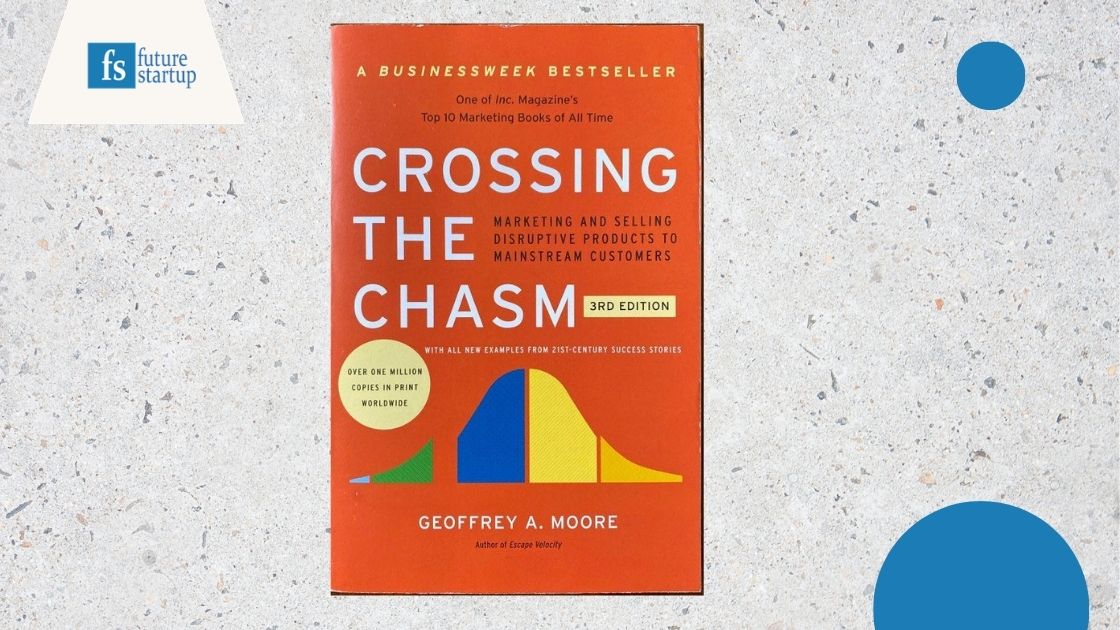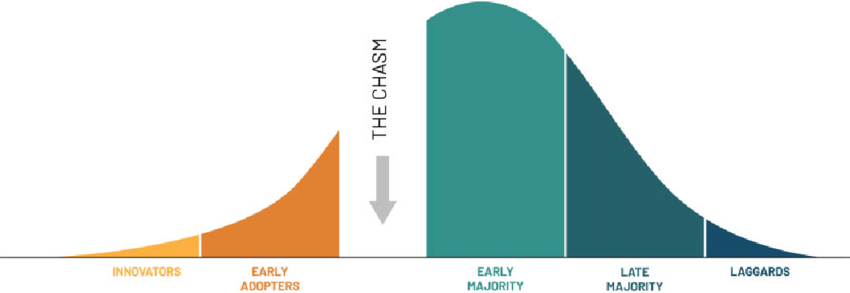
Geoffrey A. Moore published the first edition of Crossing the Chasm: Marketing and Selling High-Tech Products to Mainstream Customers in 1991, almost 32 years back. The book became an instant best-seller and a must-read for any and every marketer dealing with technology products.
The book examines the market dynamics innovative new products face, with a focus on the adoption gap that lies between early and mainstream markets that Moore calls the "chasm". He defined the “chasm” as a gap in technology adoption between ‘‘early adopters’’ and ‘‘mainstream adopters’’.
The book’s core thesis is that every technology has an adoption life cycle. Moore divided the cycle into five stages and the users you encounter in each of these stages and users, namely: innovators, visionaries, pragmatists, late majority, and laggards. The book uses a variation of the technology adoption lifecycle and suggests that there is a gap between ''early adopters'' and ''early majority'' referred to as ''the Chasm.''
An innovative startup product initially appeals to “innovators,” people who are usually open to trying new things but are seldom willing to spend much. Then comes the “visionaries,”. Visionaries are early adopters and are willing to try a new product if it solves a real problem. If they see a proof of concept, they usually take a chance on a product. Then comes the “pragmatists”, people who are also called the early majority. They usually take a product only if their friends or colleagues recommend it. Typically, the pragmatists, the “early majority”, represent by far the largest market segment. Getting to the pragmatists, “early majority, is the main challenge for a new technology product. When a company manages to bridge the chasm, it usually finds a way to get to the “late majority”, because “late majority” users only buy a product when it becomes a standard and they generally follow the “early majority”. Finally comes the “laggards,” who never buy.
Moore suggests that startups should find a strategy to cross the chase and it can’t be done by trying to find a large market. A startup should start with a small market, dominate it, and then move on to the next market.

Crossing the Chasm is considered one of the most important books in technology entrepreneurship.
In a 2014 blog post Andy Rachleff, Co-founder & Executive Chairman of Wealthfront, wrote:
“Twenty years ago, the book Crossing the Chasm was on every technology marketer’s must read list. Today few people are aware of it despite it remaining every bit as relevant as the day it was published. The lessons we applied from Crossing the Chasm to our business were a big part of Wealthfront’s rapid success — yet every step of the way competitors and pundits thought we were nuts.”
The book remains equally relevant and important for today’s entrepreneurs and founders. In this article, we bring you some fascinating quotes from the book along with some commentaries.
“Make something 10 people completely love, not something most people think is pretty good.”
“It turns out our attitude toward technology adoption becomes significant—at least in a marketing sense—any time we are introduced to products that require us to change our current mode of behavior or to modify other products and services we rely on. In academic terms, such change-sensitive products are called discontinuous innovations. The contrasting term, continuous innovations, refers to the normal upgrading of products that does not require us to change behavior.”
“Most companies fail to cross the chasm because, confronted with the immensity of opportunity represented by a mainstream market, they lose their focus, chasing every opportunity that presents itself, but finding themselves unable to deliver a salable proposition to any true pragmatist buyer.”
“To get an early market started requires an entrepreneurial company with a breakthrough technology product that enables a new and compelling application, a technology enthusiast who can evaluate and appreciate the superiority of the product over current alternatives, and a well-heeled visionary who can foresee an order-of-magnitude improvement from implementing the new application.”
“Marketing professionals insist on market segmentation because they know no meaningful marketing program can be implemented across a set of customers who do not reference each other. The reason for this is simply leverage. No company can afford to pay for every marketing contact made. Every program must rely on some ongoing chain-reaction effects—what is usually called word of mouth. The more self-referencing the market and the more tightly bounded its communications channels, the greater the opportunity for such effects. So much for first principles.”
“The number-one corporate objective, when crossing the chasm, is to secure a distribution channel into the mainstream market, one with which the pragmatist customer will be comfortable. This objective comes before revenues, before profits, before press, even before customer satisfaction. All these other factors can be fixed later - but only if the channel is established.”
“Entering the mainstream market is an act of burglary, of breaking and entering, of deception, often even of stealth.”
“Customers often bend over backward to give market share leaders second and third chances, bringing cries of anguish from their competitors who would never be granted such grace.”
“By contrast, the early majority want to buy a productivity improvement for existing operations. They are looking to minimize the discontinuity with the old ways. They want evolution, not revolution. They want technology to enhance, not overthrow, the established ways of doing business. And above all, they do not want to debug somebody else’s product. By the time they adopt it, they want it to work properly and to integrate appropriately with their existing technology base.”
“One of the most important lessons about crossing the chasm is that the task ultimately requires achieving an unusual degree of company unity during the crossing period.”
“The company failed because its managers were unable to recognize that there is something fundamentally different between a sale to an early adopter and a sale to the early majority, even when the company name on the check reads the same. Thus, at a time of greatest peril, when the company was just entering the chasm, its leaders held high expectations rather than modest ones, and spent heavily in expansion projects rather than husbanding resources.”
“Surround your disruptive core product, the thing that got you to the dance, with a whole product that solves for the target customer’s problem end to end. That will keep you on the dance floor for a long time to come.”
“Positioning is the single largest influence on the buying decision.”
